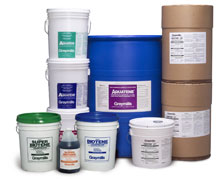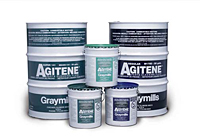Choosing the Fluid - Solvent and Aqueous Parts Washing Chemistries
Inevitably, parts will get dirty. Whether this is from handling, machining, or use, it’s your job to get them clean again.
One of the first questions you need to ask yourself when looking for a new parts washer is what sort of cleaning chemistry you want to use. This is crucial to tackle
early on, because the type of cleaning solution will determine what sort of equipment you need. And choosing the wrong one can slow down your cleaning process and lead to extra costs. If you change
your mind after making the purchase, it is difficult and expensive - if not impossible - to retrofit the equipment to use the other type.
At the end of the day, you still need to get down to the surface of your parts and get rid of contaminants, from oils to greases to dirt to dust to rust. So how do you
choose which is right for you? Let’s look at the two major categories: solvents and aqueous (water-based).
Old School: Solvent
Solvents, and in this case we are referring to typical mineral spirits cleaning solvents, are the traditional answer. Made of light petroleum distillates, they are
what many people think of when they think of parts washing.
Why have solvents been a popular choice? Quite simply, they work well. Mineral spirits cleaners dissolve petroleum-based oils and greases, cleaning very efficiently.
They also do not require additional energy inputs, such as heat, spray, and ultrasonics (side note, NEVER heat mineral spirits and never use in a spray or ultrasonic application unless approved by
the manufacturers of both the machines and the solvent) to get the job done. Usually, a soak and light brushing is all that is needed, though larger or more complex parts might necessitate pump or
platform agitation to fully flush holes and grooves.
Parts cleaned in solvent also dry fast and do not require a rinse. They typically come out rust-free.
Sounds perfect. So what’s not to love? Well, solvents have a few drawbacks.
First, they are not considered to be environmentally friendly. They are made of oil and evaporate, creating VOC (volatile organic compounds) emissions. Even if being
green isn’t top of mind for you, it is for the government. Emissions standards are constantly being tightened, and some localities have banned solvent altogether.
Second, solvents are combustible. Traditional solvents have a flash point, or the point as which vapor can be ignited by a flame, of 105-141F. Some companies do not
want to deal with having combustible fluids in their facility.
Third, service for these units is frequent - and frequently expensive. The unit has to be drained, cleaned, and refilled with fresh solvent, commonly on an 8-week
service interval. These costs add up over time.
Finally, there are not as many specialized solvents as there are aqueous solutions. Solvents tend to be more of a “one size fits all” solution.
Constant Evolution: Aqueous
Water-based (or aqueous) solutions have grown in popularity in recent years. While early versions were slow and somewhat ineffective, newer water-based cleaners rival
solvents. One difference is how they work. Where solvents dissolve oils and greases, water-based chemistries emulsify the oils, using polar surfactants to bond with both the water and the oil and
lift the contaminants away from the surface of the part.
Why have companies made the move away from solvents? One explanation is that aqueous detergents are more environmentally friendly, especially in the more neutral pH
range. They are non-combustible, though this needs the obvious clarification that dumping combustible or flammable (a flash point below 100F) products into an aqueous solution can change
this.
Another advantage is the wide variety of both machines and chemistries available. This allows you to tweak both to fit your process closely, driving efficiencies in
the system. Machines are available with heat, agitation, low- and high-pressure sprays, and ultrasonics. Chemistries have rapidly evolved and are formulated to handle everything from light dirt to
honing oil to UV-curable printing ink - and beyond. Add to this the ability to mix additives from rust preventatives to brighteners into chemistry. This mix-and-match capability can benefit your
cleaning process dramatically and help you get exactly what you want out of it.
Once more, all this sounds great. So what are the downsides?
Many aqueous systems require a post-cleaning rinse, a rust preventative dip, or drying. This means secondary steps and potentially extra equipment.
Aqueous machinery also usually costs more up-front. This is due to the need to use stainless steel on wetted surfaces to prevent rusting of the equipment. The machines
also frequently have add-ons like heaters, spray manifolds, and ultrasonic systems.
Some chemistries rely on high pH to clean effectively. Non-ferrous metals can potentially be damaged or discolored by this, so it is important to test your choices out
first before implementing. Most reputable manufacturers have the capability to offer this service.
Aqueous machines still need service. This is usually less frequent than with solvent machines, but you need to budget for the cost. One thing that will help, though,
is that many water-based chemistries are sold as concentrates, so you are paying less for shipping.
So which is best for me?
There is no one best solution for everyone. This is where a trusted advisor comes in handy. Call Graymills, and we can help you make the decision that will work best
for you. And we can prove it out in our testing lab, showing you what the real-world outcome of your cleaning process could be.
Industrial Parts Washers Cleaning Fluids
Parts washing is not solely a function of the equipment. Without appropriate cleaning chemistry, parts will not meet optimal cleanliness. Graymills offers
petroleum-based general purpose, biodegradable aqueous alkaline, and biodegradable aqueous bioremediating degreasing solutions.
Cleaning Fluid Reference Chart
|
Cleaning Problem
|
Super
Agitene
|
Regular
Agitene
|
Aquatene
330
|
Super
Aquatene
360
|
Super
Aquatene
390
|
Aquatene
571
|
Biotenes
|
|
Buffing and Lapping
|

|

|
|

|

|
|
|
|
Carbon Deposits, Soft
|
|
|

|

|

|

|

|
|
Coatings, Light
|

|

|

|

|

|

|

|
|
Grease
|

|

|

|

|

|

|

|
|
Gummy Residues
|

|

|

|

|

|

|

|
|
Inks, water based
|
|
|
|

|
|
|
|
|
Oils
|

|

|

|

|

|

|

|
|
Oils, oxidized
|
|
|
|

|

|

|
|
|
Paint, Latex
|
|
|

|

|

|
|

|
|
Paint, Oil based
|

|

|
|
|

|
|
|
|
Rust Preventatives
|

|

|

|

|

|

|

|
|
Varnishes, Light
|

|

|

|

|

|

|

|
|
Varnishes, Heavy
|
|
|
|

|

|

|
|
|
Vanishes, Burned-On
|
|
|
|

|

|
|

|
|
Waxes
|
|
|

|

|

|

|

|
|
For Use in:
|
Super
Agitene
|
Regular
Agitene
|
Aquatene
330
|
Super
Aquatene
360
|
Super
Aquatene
390
|
Aquatene
571
|
Biotenes
|
|
Clean-O-Matic
|

|

|
|
|
|
|
|
|
Handi-Kleen (cold)
|

|

|
|
|
|
|
|
|
PH922 (hot)
|
|
|

|

|
|

|
 (TB) (TB)
|
|
Turbo Parts Cleaner (cold)
|

|

|
|
|
|
|
|
|
Turbo Parts Cleaner (hot)
|
|
|

|

|

|

|
 (TB) (TB)
|
|
Liftkleen (cold)
|

|

|
|
|
|
|
|
|
Liftkleen (hot)
|
|
|

|

|

|

|
 (TB) (TB)
|
|
Spray Washing Cabinet
|
|
|
|
|

|

|
|
|
Tempest
|
|
|
|
|

|

|
|
|
Drum Mount (cold)
|

|

|
|
|
|
|
|
|
Ultrasonic
|
|
|

|

|

|
|
 (TB) (TB)
|
|
Biomatic
|
|
|
|
|
|
|
 (ALL) (ALL)
|
PRODUCT DESCRIPTION
GM550-QT
Super Biotene 550(Concentrate). A concentrated detergent designed for our Bioremediation models, although it is also a good general purpose cleaner. One quart liquid
concentrate.
GM550-1
Super Biotene 550(Concentrate). A concentrated detergent designed for our Bioremediation models, although it is also a good general purpose cleaner. One gallon liquid
concentrate.
GM660-5
Super Biotene 660(Pre-blended). Same as Super Biotene 550, but in a five-gallon pail of pre-blended, ready-to-use formula
STANDARD FEATURES
-
Super Biotene is an aqueous-based solution that is pH neutral (7.0) mixture of emulsifiers and surfactants containing no
VOCs
-
Available in one quart liquid concentrate that makes five gallons of cleaner or one gallon liquid concentrate that makes 21 gallons of
cleaner
|
HOT CLEANING FLUIDS
|
|
BIOTENE - SUPER-BIOPAK
|
|
GM660-5
|
5-gallon pre-mixed cleaning fluid
|
|
GM550-QT
|
1-quart concentrate (makes 5 gallons)
|
|
GM550-1
|
1-gallon concentrate (makes 20 gallons)
|
|
GM880-5
|
Super Biotene pre-blended solution, 5 gallon pail
|
|
*Individual 5-gallon containers may be shipped UPS with an additional $9.00 packaging, handling charge added to the shipment. Total cost will be considerably less than common carrier on less
than pallet quantities.
|
|
APPROVALS-
|
|
Regular and Super Agitene: U/L file MH3717 And City of N.Y. Approval, Certificate no. 2782
|



